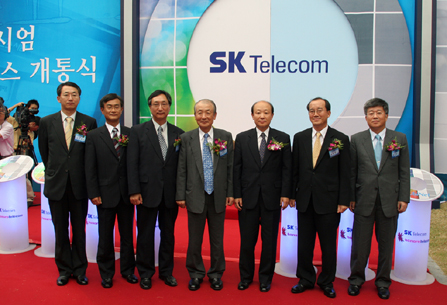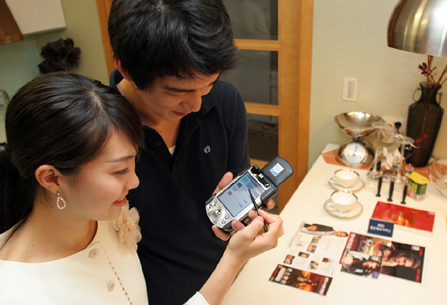content area
Press Release
SK Telecom Holds An Opening Ceremony for the BcN Trial Service
2005.09.09The UbiNet Consortium introduces 32 services in 4 groups, e.g. Voice and Data integrated services, combined Wired and Wireless services, combined Telecommunications and Broadcasting services, and Ubiquitous application services.
Wired and wireless integrated services such as a video telephony service between mobile phones and Fixed phones, and location information-based coupon service, are also being introduced.
the BcN trial service will be used in everyday life, and IT will lead to a better ubiquitous and convergence era.
The ubiquitous and convergence age has opened wide with the start of the Broadband convergence Network (BcN) service that combines wired and wireless telecommunications, as well as broadcasting and Internet, through a single network.
The UbiNet Consortium that SK Telecom is in charge of, also includes Hanaro Telecom and Samsung Electronics. The ’BcN trial service opening ceremony’ was held at Parkview in Boondang on September 9th. The participants in this ceremony were: Jung Hyung Noh, vice-minister of Information and communications, Jung Nam Cho, vice-chairman of SK Telecom, Jong Myung Lee, vice-president of Hanaro Telecom, and several other consortium officials.
At the ceremony, the UBiNet Consortium announced that its core technology will be used for 32 services in 4 groupings that will employ next-generation infrastructures. These include: ? Voice and Data integrated services ? Combined Wired and Wireless services ? Combined Telecommunications and Broadcasting services ? Ubiquitous application services.
Two examples of Voice and Data integrated services are ’multimedia coloring’ and ’multimedia lettering’. Upgraded to provide ring-back tone service for wired phones, the multimedia coloring provides streaming video and music for the caller, and the multimedia lettering service offers multimedia streaming videos to the receiver.
One of the futuristic services for Wired and Wireless combined service is ’Video-conferencing call integrated service’. This service combines the WCDMA video-telephony and BcN video-telephony that are being introduced for the first time by the UBiNet Consortium.
’Satellite Cable Network (SCN)’ for Telecom and Broadcasting combined service uses high-speed broadband to let users view ’Skylife’ broadcasts. This has been in trial service since July by SK Telecom, Hanaro Telecom and Skylife.
In addition, ’T-Communication’ service is designed to allow customers to do video-telephony calls through a TV screen when they receive calls while watching TV. This service also allows a video conferencing call that enables four people to converse at the same time, while watching each other.
Lastly, ’Zone Based Personalized Multimedia Service’ (ZBPMS), as the UBiNet Consortium’s application service, analyzes the position of a user in a specific area, and provides personalized multimedia information. The ZBPMS is a Ubiquitous Application that uses LBS (Location based service), and will be actively utilized in selected areas chosen for segmented marketing activities. The UBiNet Consortium also released the ’u-Zone Coupon and Information Service’ that offers a variety of discount coupons and information tailored to the subscribers? location and time.
The BcN trial service announced by the UBiNet Consortium strengthens SK Telecom’s core competitiveness, as well as its wired and wireless integration that can be directly used in everyday life. It will also foster a better Ubiquitous and Convergence era.
SK Telecom, together with KT and Dacom, was selected as a BcN pilot service provider in August of 2004. Since then, SK Telecom has formed a consortium with 25 private companies and public institutions, e.g. Hanaro Telecom, Skylife, Samsung Electronics, Taihan Electric Wire, Busan City Hall, and Seoul National University, in order to provide the BcN pilot services. Currently the consortium is in full swing establishing 600 BcN pilot service households in the metropolitan area, Busan, and Daejeon.
Hyung Chul Ju, head of SK Telecom’s U-Business Development Office commented, "Based on the BcN pilot service, we will construct a broadband multimedia network infrastructure with the objective of releasing a wide range of new services that will facilitate customer convenience beyond time and space. To this end, we are developing about 70 BcN core technologies in such areas as Voice and Data integrated services, Combined Wired and Wireless services, combined Telecommunications and Broadcasting services, and Ubiquitous application services".
The UbiNet Consortium that SK Telecom is in charge of, also includes Hanaro Telecom and Samsung Electronics. The ’BcN trial service opening ceremony’ was held at Parkview in Boondang on September 9th. The participants in this ceremony were: Jung Hyung Noh, vice-minister of Information and communications, Jung Nam Cho, vice-chairman of SK Telecom, Jong Myung Lee, vice-president of Hanaro Telecom, and several other consortium officials.
At the ceremony, the UBiNet Consortium announced that its core technology will be used for 32 services in 4 groupings that will employ next-generation infrastructures. These include: ? Voice and Data integrated services ? Combined Wired and Wireless services ? Combined Telecommunications and Broadcasting services ? Ubiquitous application services.
Two examples of Voice and Data integrated services are ’multimedia coloring’ and ’multimedia lettering’. Upgraded to provide ring-back tone service for wired phones, the multimedia coloring provides streaming video and music for the caller, and the multimedia lettering service offers multimedia streaming videos to the receiver.
One of the futuristic services for Wired and Wireless combined service is ’Video-conferencing call integrated service’. This service combines the WCDMA video-telephony and BcN video-telephony that are being introduced for the first time by the UBiNet Consortium.
’Satellite Cable Network (SCN)’ for Telecom and Broadcasting combined service uses high-speed broadband to let users view ’Skylife’ broadcasts. This has been in trial service since July by SK Telecom, Hanaro Telecom and Skylife.
In addition, ’T-Communication’ service is designed to allow customers to do video-telephony calls through a TV screen when they receive calls while watching TV. This service also allows a video conferencing call that enables four people to converse at the same time, while watching each other.
Lastly, ’Zone Based Personalized Multimedia Service’ (ZBPMS), as the UBiNet Consortium’s application service, analyzes the position of a user in a specific area, and provides personalized multimedia information. The ZBPMS is a Ubiquitous Application that uses LBS (Location based service), and will be actively utilized in selected areas chosen for segmented marketing activities. The UBiNet Consortium also released the ’u-Zone Coupon and Information Service’ that offers a variety of discount coupons and information tailored to the subscribers? location and time.
The BcN trial service announced by the UBiNet Consortium strengthens SK Telecom’s core competitiveness, as well as its wired and wireless integration that can be directly used in everyday life. It will also foster a better Ubiquitous and Convergence era.
SK Telecom, together with KT and Dacom, was selected as a BcN pilot service provider in August of 2004. Since then, SK Telecom has formed a consortium with 25 private companies and public institutions, e.g. Hanaro Telecom, Skylife, Samsung Electronics, Taihan Electric Wire, Busan City Hall, and Seoul National University, in order to provide the BcN pilot services. Currently the consortium is in full swing establishing 600 BcN pilot service households in the metropolitan area, Busan, and Daejeon.
Hyung Chul Ju, head of SK Telecom’s U-Business Development Office commented, "Based on the BcN pilot service, we will construct a broadband multimedia network infrastructure with the objective of releasing a wide range of new services that will facilitate customer convenience beyond time and space. To this end, we are developing about 70 BcN core technologies in such areas as Voice and Data integrated services, Combined Wired and Wireless services, combined Telecommunications and Broadcasting services, and Ubiquitous application services".



